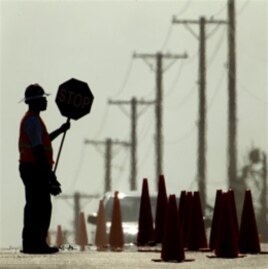
DOUG JOHNSON: Welcome to AMERICAN MOSAIC in VOA Special English.
I'm Doug Johnson. This week on our show, we play new music from Bon Iver...
We also answer a question about the hours of American workers...
But, first, we learn about a small American company that is answering a big demand for chopsticks in China.
American-Made Chopsticks
(MUSIC)
DOUG JOHNSON: In the United States, many manufactured goods include the words “Made in China.” But one small company in the American state of Georgia is making traditional Chinese chopsticks -- and sending them to China. Faith Lapidus has more.
FAITH LAPIDUS: Chopsticks are sticks used in some Asian countries to eat food. They are often made out of wood, but can also be made of plastic. Most of the world’s chopsticks are made in China. Several hundred Chinese manufacturers produce about sixty three billion pairs of chopsticks a year. However, those manufacturers need more wood.
One small company in the American city of Americus, Georgia has recognized this demand.
It started producing chopsticks for export to China. Korean-American Jae Lee is the president of Georgia Chopsticks. He says the world market for chopsticks is huge.
JAE LEE: “Right now, we are making about two million pairs of chopsticks per day. But we are increasing. End of this month, we’ll have seven machines coming in. So it’ll increase to like four million per day. End of this year, we will produce ten million per day.”
FAITH LAPIDUS: About one-third of the world’s population uses chopsticks. Japan, for example, uses about twenty three billion pairs of the sticks each year.
China may need more wood for producing chopsticks. But David Garriga says there is plenty of wood near Americus, Georgia. Mr. Garriga is the head of the local economic development council.
DAVID GARRIGA: “Rural Georgia and the cities of rural Georgia, they’re blessed with tons of natural resources. The Pacific Rim, especially areas in China and Japan, they’ve run out of wood, but we have an abundance of it.”
In central Georgia, sweetgum and poplar trees grow in large numbers. In fact, these trees make good chopsticks. This is because the wood is not firm and has a nice color. Unlike many Asian chopsticks, these Georgia-made chopsticks do not need to be lightened with chemicals and bleach.
Georgia Chopsticks opened at the end of last year. It received four hundred fifty requests for jobs in just two weeks. Today, the company employs fifty seven people at its factory. Jae Lee hopes to increase production and add one hundred more workers by the end of the year.
Every chopstick his company makes goes to Asia, where they are sold to stores in China, Korea, and Japan. Right now, Georgia Chopsticks cannot keep up with demand for its product.
It costs Jae Lee less than one cent to make a pair of chopsticks. But he says he is not making any money yet. To earn a profit, he needs to produce more than four million chopsticks a day. He says he hopes to do this in the next month or two.
David Garriga notes that the American connection to the production of chopsticks has a funny side.
DAVID GARRIGA: “Suddenly, there’s a huge nation, the fastest growing in the world, that finances part of our national debt, and here we are making their basic products and shipping it to them, like they’ve done for us for years. It’s just kind of a reverse.”
(MUSIC)
Work Hours in US
DOUG JOHNSON: Our question this week comes from China. Lisa wants to know about the work hours of Americans. Lisa says she works from seven thirty until eleven in the morning. She then has an hour to eat and rest. She returns to work at twelve, and stays on the job until four thirty.

Her question is timely since the Bureau of Labor Statistics recently released results of its American Time Use Survey for twenty ten. The survey began in two thousand three. Its aim was to provide estimates about how, where and with whom Americans spend their time. This kind of information can be helpful to media organizations, economists, sociologists and other experts as part of their research.
Rachel Krantz-Kent is program manager of the American Time Use Survey. She says one finding showed that men who have a job worked, on average, more hours than employed women.
RACHEL KRANTZ-KENT: “One of the interesting things we know from the American Time Use Survey is that, on average, American men spend more time working for pay than American women. However, while men work more hours than women, we also observe that women are spending more time providing childcare and doing household work such as cleaning and food preparation.”
The American Time Use Survey found that employed people work an average of seven and a half hours a day. Full-time male workers average 8.2 hours a day, while women average 7.8 hours.
The report shows that more people work on weekdays than on Saturday and Sunday – the traditional weekend days. Eighty-two percent of employed people work on an average weekday, compared with thirty-five percent who work on an average weekend.
The report notes the times individuals work. Between two thousand five and two thousand nine, over fifty percent of American workers were at their job by eight in the morning.
The report also tells how Americans spend their time away from work.
On an average day, nearly everyone fifteen years of age and older took part in a non-work activity like watching television, socializing or exercising. The study found that people spend an average of 2.7 hours a day watching television.
Time spent reading was linked to age. Adults seventy-five years and older averaged 1.1 hours of reading a day on weekends. But people between the ages of fifteen and nineteen averaged about six minutes of reading a day. Those individuals spent more time playing games or using a computer for non-work activities.
How many hours do you spend at work and at play? Leave a comment on our website, voaspecialenglish.com.
(MUSIC)
Bon Iver
HOST: Bon Iver is the musical project of singer and songwriter Justin Vernon. His second album, “Bon Iver” has received praise from critics across the United States. One reporter says this album proves that rock is not dead -- it is only sleeping and dreaming. Jim Tedder has more.
(MUSIC)
JIM TEDDER: That was the song “Calgary.” Like many songs on the album “Bon Iver” this one is soft, dreamy, and poetic. It is often hard to understand the meaning of the words Justin Vernon is singing.
But what is clear is that every song is linked to a place. All of the songs are named after a place, either real or imaginary. Justin Vernon is more interested in listeners having an emotional experience from his music than understanding meaning of the words.
His first album, “For Emma, Forever Ago,” was released in two thousand seven. He recorded most of the music in a small house in the woods in his native Wisconsin. He went there to be alone for several months and to recover from personal problems, including the breakup of his band.
The extreme quiet had a major influence on him. He began to write new music. This resulted in the creation of an album that caught the attention of several performers, including Kanye West. He asked Justin Vernon to work with him on his two thousand ten album “My Beautiful Dark Twisted Fantasy.”
On his latest album, Justin Vernon has expanded his sound and added more musical instruments and effects.
(MUSIC: “Minnesota, WI”)
We close with the last song on the album “Bon Iver, Bon Iver.” “Beth/Rest” sounds like it could have been recorded in the nineteen eighties. Justin Vernon says he loves the song and wanted it to be last on his album. He says he wants listeners to get lost in its sound.
(MUSIC)
DOUG JOHNSON: I’m Doug Johnson. Our program was written and produced by Dana Demange, with reporting by Philip Graitcer. If you have a question about American life, write to mosaic@voanews.com.
Join us again next week for music and more on AMERICAN MOSAIC in VOA Special English.
(MUSIC)




